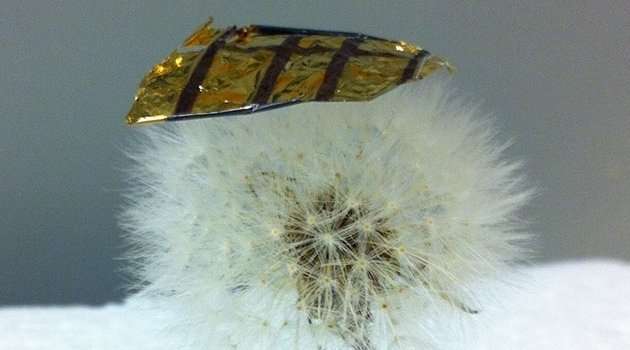New technology heralds easy and innovative ways to catch rays

In a new study, Erik Johansson's research team at the Department of Chemistry at Ångström Laboratory in Uppsala has shown that a new technology using quantum dots can be used to produce a new type of extremely lightweight, flexible and environmentally friendly solar cells.
Solar cells have made a huge breakthrough in our society over the past 5-10 years, with a staggering 50 per cent annual market growth. Silicon solar cells currently dominate the market. But new research points to alternative solar cells that can be manufactured using simpler and cheaper methods.
Erik Johansson's research team at the Department of Chemistry – Physical Chemistry studies solar cells based on organic/inorganic nanoscale composites. The goal is to find new and effective material combinations to produce efficient and environmentally friendly solar cells, and they are using advanced techniques to understand how solar light is converted into electricity. Their research findings are then used to optimise the solar cells. But they are also studying methods to produce solar cells on a larger scale.
In a new study, the research team has shown that extremely lightweight and flexible solar cells can be made from nanoscopic crystals known as quantum dots. They are made on a thin plastic film and the technology that the solar cells is based on makes it possible to manufacture the cells at low temperatures (otherwise the plastic film would melt). Because the solar cells do not consist of large crystals (which could crack if they are bent) but instead of a film of the nanoscopic crystals (quantum dots), they are also very flexible.
Complicated process
"The process of producing the new lightweight solar cells is rather complicated," says Erik Johansson. "We first had to manufacture quantum dots of a high quality, which have good light absorption and a minimal number of defects ('defects' refers to e.g. an atom missing inside or on the surface of the quantum dot). We've also developed a transparent contact on the plastic that consists of silver nanowires. The silver nanowires are several hundred micrometres in length, but only about 30 nanometres in width. A solution containing silver nanowires is placed on the plastic, and when it dries an (irregular) network of silver nanowires is formed that can conduct electricity, but which still allows light to pass through the network. A thin layer of zinc oxide from the solution is deposited on this network and the quantum dots are then deposited on the zinc oxide. Finally, a thin layer of gold is placed over the quantum dots to form a second contact. The solar cell is then complete."
Lightweight solar cells offer a number of advantages. For one, much less energy and materials are consumed in the manufacturing of the solar cells. For another, large volumes of solar cells can be transported from the production site to the application site with significantly less energy consumption. All in all, much less energy is therefore needed for the manufacturing and transport of lightweight solar cells, which can thus make them more environmentally friendly than heavier cells.
"New applications can also be found for lightweight and flexible solar cells," says Johansson. "These solar cells could, for example, potentially be added as an extra layer on roofs or building façade materials in the future. Other applications for lightweight solar cells could include aircraft or spacecraft, where the weight of solar cells is especially important."
The prototype solar cells developed by the research team are very small (about one square centimetre ). What is needed for large-scale manufacturing of this type of solar cell is to show that the solar cells can be made on larger surfaces, that they are stable over a long period of time (several years) and that they can cope with e.g. low and high temperatures.
"There is a long path ahead before the product can be launched on the market, but this research study is the first step towards the ultra-lightweight and flexible solar cells of the future," says Johansson.
The results of the study have recently been published in the journal Energy and Environmental Science.
More information: Xiaoliang Zhang et al. Extremely lightweight and ultra-flexible infrared light-converting quantum dot solar cells with high power-per-weight output using a solution-processed bending durable silver nanowire-based electrode, Energy & Environmental Science (2017). DOI: 10.1039/C7EE02772A
Journal information: Energy and Environmental Science , Energy & Environmental Science
Provided by Uppsala University





















